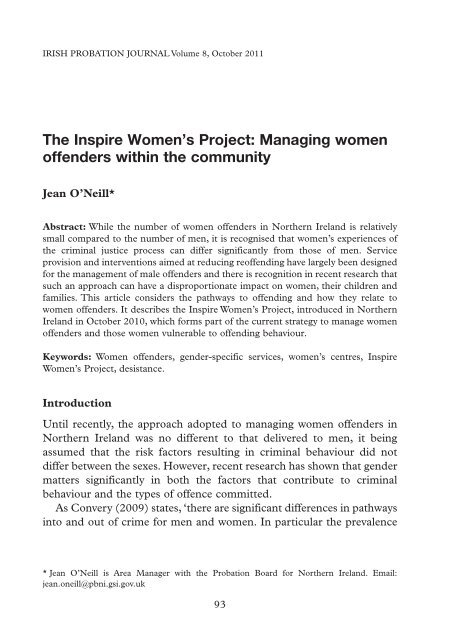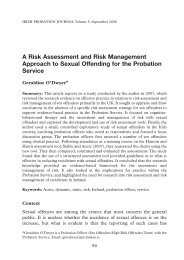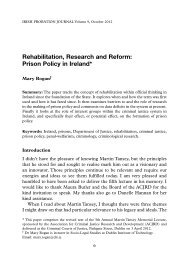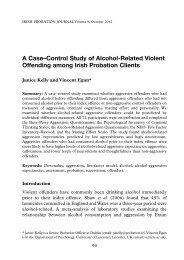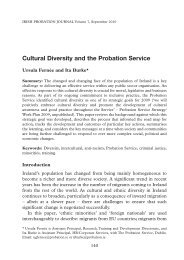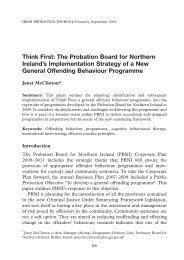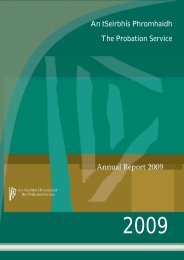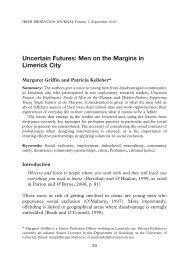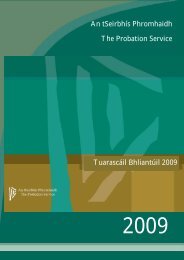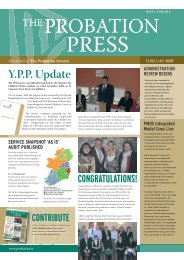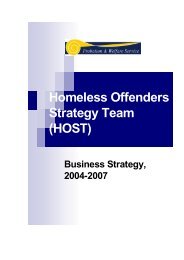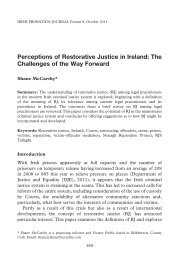The Inspire Women's Project: Managing women offenders
The Inspire Women's Project: Managing women offenders
The Inspire Women's Project: Managing women offenders
You also want an ePaper? Increase the reach of your titles
YUMPU automatically turns print PDFs into web optimized ePapers that Google loves.
94 Jean O’Neillof static and non-criminogenic factors identified among <strong>women</strong> whooffend and the relatively low reoffending rates for <strong>women</strong> indicatedifferent pathways for <strong>women</strong> compared with men.’Women within the criminal justice system differ from men in thatfewer <strong>women</strong> offend than men, and where they do, <strong>women</strong> generallycommit fewer offences than men. On the whole, <strong>women</strong> commit lessserious offences and are more likely to desist from crime (Arnull andEagle, 2009). <strong>The</strong> literature on <strong>women</strong> offending, although largelyfocused on adult <strong>women</strong> and particularly skewed towards <strong>women</strong> incustody, concludes that gender matters significantly in shapingcriminality (Bloom et al., 2003).<strong>The</strong>re is extensive evidence that <strong>women</strong> who are involved in offendingoften have a history of physical and sexual abuse in childhood and intoadulthood (Rumgay, 2001; Gelsthorpe, 2003). Other factors associatedwith offending behaviour in <strong>women</strong> include weak social ties, strainedfamily relationships, abuse of drugs and alcohol, low educationalattainments, severe social exclusion, accommodation problems and thestrains engendered by child-rearing responsibilities coupled with lowincome and dependence on state benefits (Byrne and Trew, 2008). It istherefore important that the planning of effective services must takeaccount of the knowledge and understanding of ‘factors which areunique or more relevant to <strong>women</strong>’ (Hedderman, 2004, p. 242). Treating<strong>women</strong> <strong>offenders</strong> with strategies that focus on male criminogenic factorsis recognised as both inefficient and counterproductive in terms of time,resources and outcomes.Best practice strategies need ‘to take into account distinctive featuresof <strong>women</strong>’s lives and needs in order to facilitate effectiveness’(Gelsthorpe et al., 2007, p. 200). <strong>The</strong> problem is compounded by the‘lack of research in decisions made by the police, prosecution, probationand courts, and practices adopted in the supervision of <strong>women</strong> in thecommunity’ (Convery, 2009, p. 21).Women <strong>offenders</strong> in Northern IrelandAccording to the most recent data compiled by the Department ofJustice, only 13% (3428) of those who passed through courts inNorthern Ireland in 2006 were <strong>women</strong>. <strong>The</strong> most commonly committedoffence type among <strong>women</strong> was ‘theft’, with 11% of <strong>women</strong> <strong>offenders</strong>committing this offence compared to only 6% of men.
<strong>The</strong> <strong>Inspire</strong> Women’s <strong>Project</strong> 95Indeed, when offences of fraud and forgery are included, suchacquisitive-type crime represents 13% of overall <strong>women</strong> offendingcompared to 7% for men, which would reflect the propensity for <strong>women</strong>to engage in financially motivated crimes that are often brought about byfamily and personal circumstances.On 31 January 2011, PBNI was supervising 395 <strong>women</strong> <strong>offenders</strong>,representing 9% of all <strong>offenders</strong> under PBNI supervision. <strong>The</strong> mainoffence types for <strong>women</strong> subject to supervision at this time were theft,violence against the person and deception, fraud and forgery offences. Animportant difference between the genders is that fewer <strong>women</strong> than menare assessed as high risk in terms of likelihood of reoffending: 19% of<strong>women</strong> were subject to community supervision on 30 June 2011compared to 27% of men. Likewise, 2% of all females were assessed asbeing of risk of causing serious harm to others (RoSH) compared to 4%of all males. PBNI statistics on reconviction in Northern Ireland showthat for those <strong>offenders</strong> who received a Probation Order in 2005, 20% of<strong>women</strong> compared to 27% of men reoffended within 12 months.In May 2011 there was an average of 48 <strong>women</strong> <strong>offenders</strong> in prison inNorthern Ireland, which represents 3% of the total overall prisonpopulation. This is a comparatively low rate compared with GreatBritain, the Republic of Ireland and most of Western Europe. Women aremore likely than men to be committed to custody on remand (48%compared with 34%). While the number of prison receptions for mendecreases after 28 years of age, the same is not true of <strong>women</strong>, with a highpercentage of committals into custody among <strong>women</strong> aged 40–49 years.Women subject to community supervision orders tend to be older: justover a third (34%) of male <strong>offenders</strong> compared to 46% of females areaged 35 and over.Pathways into offending behaviourWith regard to the factors that shape criminal behaviour, or pathwaysinto crime, there is ongoing debate and discussion as to theappropriateness of applying the ‘risk, need and responsivity model’ to<strong>women</strong> <strong>offenders</strong>. <strong>The</strong> risk need model is based on criminogenicneeds/dynamic factors and has ‘become highly influential in guidingresearch and practice in the criminal justice area’ (Hollin and Palmer,2006). Formal risk and assessment measurement tools such as theAssessment, Case Management and Evaluation System (ACE) (Best,
96 Jean O’Neill2007) and the Home Office Offender Assessment System (OASys)(Raynor, 2000) were developed for use in predicting the likelihood offurther offending and case management.It has been argued that the ‘dynamic risk factors’ that have influencedsuch assessment were constructed through investigations amongpredominantly male <strong>offenders</strong> and therefore concerns have been raisedas to the applicability of these assessment tools in assessing <strong>women</strong>’sneeds (Blanchette, 2004). <strong>The</strong>se concerns have led to the emergence ofthe ‘pathways’ approach, which recognises the needs of <strong>women</strong> <strong>offenders</strong>and those who are at risk of offending as being multiple, complex,interrelated and distinctive (Gelsthorpe and Sharpe, 2007). <strong>The</strong>‘pathways perspective’ incorporates a whole life perspective in the studyof crime causation. Based on extensive interviews with <strong>women</strong> <strong>offenders</strong>,it sequences life events that shape <strong>women</strong>’s choices and behaviours.This approach has established that <strong>women</strong> enter the criminal justicesystem in different ways from male <strong>offenders</strong> in terms of:• the role of violence, trauma and substance misuse• the type of offence and reoffending patterns• the impact of responsibilities for children and other dependent familymembers and a reduced ability to support self and children• connections with violent and substance-abusing partners (Bloom etal., 2003).It is necessary to understand the specific and significant pathways thatneed to be addressed in order to provide a strategic, proportionate,holistic and integrated approach to the management of <strong>women</strong> whooffend. <strong>The</strong> pathways that most impact on <strong>women</strong>’s lives includefinancial, family and child care responsibilities, education andemployment, accommodation and mental health.Poverty and financial difficultiesStudies of the experiences of <strong>women</strong> <strong>offenders</strong> and their characteristicsshow that poverty, social exclusion and deprivation are significantpathways to offending. Byrne and Trew (2008) in their Northern Irelandstudy state that offending by <strong>women</strong> commonly occurs in the ‘contextsof restricted resources and limited choices’. For most <strong>women</strong> in theirstudy the motivation for offending was triggered by finance-related
<strong>The</strong> <strong>Inspire</strong> Women’s <strong>Project</strong> 97problems such as poverty, parental and child care responsibility anddependence on state benefits. In a study of reintegration needs of <strong>women</strong>prisoners in Northern Ireland, Roberson and Radford (2006) found that64% of <strong>women</strong> were dependent on social security benefits prior to theircommittal to custody. Debt and financial pressures and having to cope asa single parent were identified in PBNI pre-sentence reports as relevantissues for <strong>women</strong> (Bailie, 2006). Financial difficulties were also cited byGelsthorpe et al. (2007) as the most significant dynamic risk leading tooffending by <strong>women</strong>, which may ‘severely restrict how successful theymay be in avoiding further offending’ (p. 17).Children and familyFor <strong>women</strong> who experience lack of child care support, a communitysentence can present serious difficulties in terms of endeavouring tocomply with the conditions of the order and at the same time caring forthe needs of their family. <strong>The</strong>se conflicting demands by their very natureimpinge more heavily on <strong>women</strong> <strong>offenders</strong> than on men. Helping <strong>women</strong>to maintain their family ties and responsibilities is critical in any strategyaimed at reducing offending. Even taking the offending out of theequation, it is important for female <strong>offenders</strong>’ emotional andpsychological health that practical advice and support be available tothem and their families.Education and employmentMany <strong>women</strong> <strong>offenders</strong> have low educational achievements and lackbasic skills and abilities (Department of Justice, 2010). Enhancingemployment and employment opportunities in particular is ‘animportant focus for gender specific interventions’ (Arnull and Eagle2009). <strong>The</strong> Independent Monitoring Board (2008, para 2.10) stressedthe particular importance of employment and accommodation on releasefrom custody to reduce the likelihood of <strong>women</strong> reoffending.AccommodationProblems of accommodation, particularly homelessless, are frequentlylinked with offending and these problems are ‘often complicated bymental health issues’ (Roberson and Radford, 2006). Seymour and
98 Jean O’NeillCostello (2005) found that 50% of the <strong>women</strong> in their study in theRepublic of Ireland were homeless on committal. <strong>The</strong>ir results indicatethat the risk of ending up in the criminal justice system is greater forhomeless <strong>women</strong> than for those in accommodation. Again, this is an areawhere little research exists for Northern Ireland; however Robertson andRadford (2006) found that a significant percentage of <strong>women</strong> hadexperienced housing problems: for instance, 36% of <strong>women</strong> prisonersdid not know where they would live on release and 44% and 32%respectively had had experience of living in a hostel and in care.Mental and physical health issuesWhile not so important in male offending behaviour, evidence indicatesthat physical and mental health issues are a concern for many <strong>women</strong><strong>offenders</strong>. Depression, anxiety and self-harming behaviour are moreprevalent among female <strong>offenders</strong> (Belknap and Holsinger, 2006; Bloomet al., 2003). In their study of <strong>women</strong> on remand in British prisons,Hollin and Palmer (2006) found that 59% of <strong>women</strong> suffered from someform of mental disorder. <strong>The</strong> most frequently reported conditions werepersonality, mood, anxiety and psychotic disorders. Moreover, Talbot(2007) reported that 70% of <strong>women</strong> prisoners suffered from two or moremental health problems. A study in 2005 found that 60% of <strong>women</strong>prisoners interviewed had been taking some form of medication prior totheir committal, 68% had been referred for psychiatric assessment, 88%had experienced depression and 60% had suffered from panic attackswhile in prison. Almost one third (32%) of the <strong>women</strong> prisonersinterviewed had attempted self-harm and almost half (48%) reportedthoughts of self-harm. A PBNI study of the needs of <strong>women</strong> <strong>offenders</strong>under supervision indicated a relatively high prevalence (44%) of <strong>women</strong><strong>offenders</strong> in Northern Ireland with mental health issues.Substance and alcohol misuseAlthough substance and alcohol misuse is related to men’s and <strong>women</strong>’soffending, it has been suggested that it has a unique impact on <strong>women</strong>,given its high co-occurrence with other problems, particularly related tomental health and histories of victimisation (McLellan, 2006). Substanceand alcohol misuse are now significant factors in <strong>women</strong>’s offending inNorthern Ireland. Roberson and Radford (2006) reported that 70% of
<strong>The</strong> <strong>Inspire</strong> Women’s <strong>Project</strong> 99the <strong>women</strong> prisoners misused drugs and/or alcohol prior to committal tocustody.<strong>The</strong> Northern Ireland Office (2009) cites a 2008 snapshot ofNorthern Ireland <strong>women</strong> prisoners showing that 50% had a history ofalcohol misuse and 40% had misused drugs.An analysis of <strong>women</strong> <strong>offenders</strong> under PBNI supervision (June 2010)found that 32% had alcohol related problems, a further 9% had drugproblems and 16% had problems with both alcohol and drugs. <strong>The</strong>sewere all factors related to their offending behaviour.Byrne and Trew (2008) found that among <strong>women</strong> <strong>offenders</strong> alcoholmisuse, as well as their offending, was linked to negative personalrelations, financial difficulties, parental responsibilities, poor mentalhealth and emotional problems. Thus it can be seen that the difficultiesin managing <strong>women</strong> <strong>offenders</strong> are a number of complex, interlocking andrelated issues, and any strategy aimed at reducing reoffending must takeaccount of the multifactorial nature of the problems facing <strong>women</strong><strong>offenders</strong>.Overall strategyIn recognition of gender-specific pathways, and following a consultationprocess, the Northern Ireland Office (NIO) in 2009 published its DraftStrategy for the Management of Women Offenders in Northern Ireland. <strong>The</strong>overall aim of the draft strategy was to develop a coordinated, long-term,sustainable approach to addressing the needs of <strong>women</strong> <strong>offenders</strong> inNorthern Ireland. <strong>The</strong> document advocated the need to develop morecreative and constructive ways of dealing with <strong>women</strong>’s offending and toreduce the use of imprisonment wherever possible. <strong>The</strong> strategy has fivekey strands:• to provide alternatives to prosecution and custody• to reduce the number of <strong>women</strong> coming through the criminal justicesystem• to ensure that, when <strong>women</strong> are sentenced, their needs are met in thecommunity wherever possible• to develop a tailored approach to the management of <strong>women</strong> incustody• to take forward the options for developing a new purpose-built facilityfor <strong>women</strong> prisoners.
100 Jean O’NeillIn 2010, following consultation on the draft strategy, the DOJ publishedthe full strategy titled Women’s Offending Behaviour in Northern Ireland: AStrategy to Manage Women Offenders and Those Vulnerable to OffendingBehaviour 2010–2013. <strong>The</strong> ministerial foreword to this strategyrecognises that in order to ‘meet the specific needs of <strong>women</strong> <strong>offenders</strong>,the criminal justice system must provide a different response to thattargeted at men’ (Department of Justice, 2010).<strong>The</strong> Probation Board for Northern Ireland set up the <strong>Inspire</strong> Women’s<strong>Project</strong> in October 2008 ‘to develop and deliver in the community a new,enhanced range of <strong>women</strong>-specific services which directly contribute toreducing <strong>women</strong>’s offending through targeted community basedinterventions’ (DOJ, 2010) This is a pilot project that will run untilMarch 2012 and will pilot the development and refining of a range of<strong>women</strong>-specific services to meet the needs of <strong>women</strong> <strong>offenders</strong>. It plansto co-ordinate community provision for <strong>women</strong> <strong>offenders</strong> and present amodel for use throughout the PBNI.<strong>The</strong> <strong>Inspire</strong> Women’s <strong>Project</strong><strong>The</strong> <strong>Inspire</strong> Women’s <strong>Project</strong> provides probation supervision for <strong>women</strong><strong>offenders</strong> subject to community supervision on relevant orders andlicences, prepares pre-sentence assessment reports, and offersresettlement opportunities for a small number of <strong>women</strong> on day release.<strong>The</strong> project encourages <strong>women</strong> <strong>offenders</strong> to address their complex needsin order to reduce the likelihood of further offending, by adopting aholistic and ‘<strong>women</strong>-centred’ approach to dealing with the issues thatlead to offending.<strong>The</strong> project provides a <strong>women</strong>-only space for <strong>women</strong> to attendProbation appointments, complete offence-focused programmes such asthe Think First Programme, a Home Office accredited cognitivebehaviour programme for <strong>women</strong> who have more than three previousconvictions, anger management programme, alcohol managementprogramme and drug counselling, which are delivered by both Probationstaff and a range of other support programme providers. <strong>Inspire</strong> also runsthe GOALS UK programme, which is a life coaching programme aimedat increasing self-esteem and responsibility.<strong>Inspire</strong> Women’s <strong>Project</strong> has a core team of four Probation Officers, aNIACRO worker, a project worker employed by the Women’s SupportNetwork (WSN), an administration officer and manager, with access tothe overall professional support provided by the Probation Board for
<strong>The</strong> <strong>Inspire</strong> Women’s <strong>Project</strong> 101Northern Ireland. Childcare is available within <strong>Inspire</strong> and, ifappropriate, can be sourced locally through a range of providers.<strong>The</strong> <strong>Inspire</strong> Women’s <strong>Project</strong> has developed links beyond Belfast Cityand with a wide range of service providers across the voluntary sector.<strong>The</strong>se partner agencies deliver a range of services and support to <strong>women</strong>attending <strong>Inspire</strong>, and, for example, include the Prison Arts Foundation(PAF), which delivers a creative arts programme with a focus on creativewriting, and the Forum for Action on Substance Abuse (FASA), whichprovides drug and alcohol services. Barnardos provides a parentingprogramme and family support. NIACRO has one worker permanentlybased at <strong>Inspire</strong> to provide support services in assisting <strong>women</strong> to resettlein their communities. NIACRO also provides Jobtrack for Women, andhas a staff member dedicated to providing employment advice, supportand training to <strong>women</strong> both in custody and in the community. <strong>The</strong>project has commenced a pilot programme with Business in theCommunity which provides mentoring support to <strong>women</strong> seekingemployment.<strong>Inspire</strong> also liaises with a wide range of other statutory, voluntary andcommunity agencies including housing, Social Services, Women’s Aid,Addictions N.I., etc. <strong>Inspire</strong> is keen to develop restorative justicepractices and refers to projects such as Alternatives and CommunityRestorative Justice Northern Ireland.One significant development is the strategic partnership between<strong>Inspire</strong>, NIACRO and the WSN, which provides a model of partnershipbetween the statutory, voluntary and community sectors in the provisionof services to <strong>women</strong> <strong>offenders</strong>. <strong>The</strong> three organisations developed theWomen Community Support <strong>Project</strong> (WCSP), which provides a range ofservices to <strong>women</strong> both in the community and in custody. Thispartnership allows for individual programmes to be tailored andprovided by the agencies involved, thus ensuring a more efficient use ofresources. One of the main benefits is that the offer of support isprovided to <strong>women</strong> subject to community supervision orders, those incustody and – particularly importantly – those who are beyond theduration of their probation order. This longer term provision supportskey needs (e.g., employment, health, financial advice).<strong>The</strong> WCSP also provides training for staff in <strong>women</strong> centres inworking with <strong>women</strong> who have had experience of the criminal justicesystem. This capacity-building programme was developed and deliveredby NIACRO and is currently being rolled out to other <strong>women</strong>
102 Jean O’Neillcentres/<strong>women</strong>’s groups in Northern Ireland. It is now accredited by theNational Open College Network (www.nocn.org.uk). <strong>The</strong> partnershiphas been strengthened by the employment of a project worker to act asthe support worker between WSN and <strong>Inspire</strong>. Her role is to takereferrals from the Probation Staff working within <strong>Inspire</strong> for <strong>women</strong> toengage within <strong>women</strong> centres and support groups in their area. This hasassisted the referral process and provides practical support to <strong>women</strong> asthey link with the <strong>women</strong> centres.Guiding principles for working with <strong>women</strong> within <strong>Inspire</strong>Gender matters<strong>The</strong> <strong>Inspire</strong> team is based on the emerging knowledge of what works with<strong>women</strong> <strong>offenders</strong> in the community (Gelsthorpe et al., 2007). <strong>The</strong>starting point is that gender matters. <strong>The</strong> primary focus of <strong>Inspire</strong> is toensure that <strong>women</strong> fulfil the requirements of the court order; it does soby adopting a <strong>women</strong>-centred approach. Many of the <strong>women</strong> havehistories of sexual abuse and violence, and other experiences that can bevery distressing. It is important to provide a safe, <strong>women</strong>-onlyenvironment where <strong>women</strong> can be assisted to address the impact of theseexperiences, to improve self-esteem, be empowered to take control oftheir lives and thus reduce the likelihood of their reoffending.Encouraging appropriate change<strong>The</strong> dependence of many <strong>women</strong> <strong>offenders</strong> on men, substances,prescription medication and welfare benefits can result in feelings ofhopelessness and despondency. Women need to have meaningful optionsthat will allow them to make responsible choices. Women also need to besupported and encouraged to experience the success associated withmaking positive, responsible choices. Probation staff through the use ofprogrammes and motivational interviewing will encourage <strong>women</strong> toengage in courses available within the community. <strong>The</strong> NIACRO andWSN staff members actively assist <strong>women</strong> in attending suchprogrammes.Evaluation of the projectAn initial evaluation was carried out by the London South BankUniversity in July 2010. A mixed methodological approach was adopted
<strong>The</strong> <strong>Inspire</strong> Women’s <strong>Project</strong> 103which combined an analysis of quantitative data and semi-structuredqualitative interviews with <strong>women</strong> <strong>offenders</strong> and stakeholders involved inthe development and delivery of the <strong>Inspire</strong> Women’s <strong>Project</strong>. <strong>The</strong> mainfindings from this evaluation include the following.Having a <strong>women</strong>-only service was identified as an important elementof the project in that <strong>women</strong> felt more comfortable, able to open up anddiscuss key elements of their offending behaviour and personalcircumstances. This aspect of provision at <strong>Inspire</strong> was considered bythose interviewed as particularly important for <strong>women</strong> <strong>offenders</strong> whohad experienced domestic and sexual violence.And I thought thank God it’s just <strong>women</strong>, there’s nobody judging me. Andthey don’t judge so it’s brilliant … and <strong>women</strong> feel more comfortable in aroom full of <strong>women</strong> rather than men because, not myself personally but<strong>women</strong> I’ve come in contact with, have been abused and all sorts so it’s veryimportant for them too. It was interesting for me to watch on the sidelineshow important it was for them type of <strong>women</strong>. (Interview 8, 53 years old)I think it’s quite a good idea whenever it’s just females especially when you’rehaving a class or stuff ’cause it’s easier to talk when there’s just females here.(Interview 37, 25 years old)According to <strong>women</strong> <strong>offenders</strong>, one of the better features of <strong>Inspire</strong> is theattitude and behaviour of the staff. <strong>The</strong> Probation Officers and staff fromvoluntary and community projects were seen to be non-judgemental,supportive and empathetic, all of which were instrumental in buildingpositive rapport, encouraging <strong>women</strong> to accept being on probation andfacilitating their engagement with the project. Women <strong>offenders</strong> reportedthat this approach allowed them to be open, to talk more about theirsituation, to seek appropriate support and to move on with their lives.I just think it’s a great facility [<strong>Inspire</strong>], the support that you get with it andthey’re non-judgemental as well. I could phone my Probation Officertomorrow and say, you know, ‘I’ve relapsed, I’m sitting here drunk’ and shewouldn’t, she wouldn’t criticise and look down her nose at me she say ‘rightwell how can we fix this? How can we get this back on track?’ and I knowthat I could just come down here and press that buzzer and there’d besomebody available for me. It’s just, for me personally, it’s been fantastic …Just the support and the non-judgementalness, if that’s the word. (Interview13, 48 years)
104 Jean O’Neill<strong>The</strong> evaluation acknowledged the importance of <strong>Inspire</strong> alongside otherstatutory and voluntary agencies to provide practical support in areassuch as domestic violence, dealing with childhood sexual and domesticviolence, mental health, debt management and housing issues. As notedin the evaluation, this support provides a sense of progression and changein <strong>women</strong>’s lives.[NIACRO worker] helped me with filling in forms to get my sickness benefit,she helped me with housing. She actually took me out to look at houses andthings that were frightening me which were wee tiny things and she calls atmy house, she’s on the other end of a phone if I need her and I’ve never hadthat support before. She’s incredible. (Interview 32, 58 years old)Twenty-eight (76%) of the <strong>women</strong> <strong>offenders</strong> interviewed reported thattheir self-esteem and/or self-confidence had improved as a direct result oftheir engagement with <strong>Inspire</strong>.I couldn’t talk about anything, I would go to talk and then it was crying andthen I couldn’t get a word out and then I couldn’t talk about that and thenthis shakiness would start and if somebody asked me a question I’d startcrying again. I was a wreck, an absolute wreck. But only for this place Idon’t know where I would have been and I doubt that I could have done iton my own. (Interview 25, 56 years old)My confidence grown a lot since being able to come down here and speak to[Probation Officer] about things and I’m more determined to go out and dothings more compared to a couple of years ago when I would have just goneand buried my head in the sand and that was it. Now I’m more determinedto get out and do things. (Interview 27, 38 years old)<strong>The</strong> ACE score is used by the PBNI to assess offender risks andunderlying criminogenic and social needs. Scores are calculated across arange of 11 components to create an overall score out of 99 whichprovides a measure of the risk of reconviction (Raynor, 2000). Anexamination of ACE scores for 309 <strong>women</strong> <strong>offenders</strong> showed an averagethree-point reduction between a woman’s start date with <strong>Inspire</strong> (21)and her most recent score (18). <strong>The</strong> average ACE level reduced frommedium to low over this time. Given that the majority of <strong>women</strong> fall intothe low to medium categories in their likelihood of reoffending, thisreduction in ACE score is statistically significant.
<strong>The</strong> <strong>Inspire</strong> Women’s <strong>Project</strong> 105I do think that in here stops me reoffending because I’ve heard the experienceof prison, what it’s like … Plus there’s support here and I don’t want to godown that line again, that’s why I keep coming here, because I don’t wantto. I want to keep myself out of trouble and this keeps me out of trouble.(Interview 22, 42 years old)Although it was not possible to access formal data concerningreoffending for this initial evaluation, interviews with <strong>women</strong> <strong>offenders</strong>showed that self-reported reoffending had substantially decreased due toengagement with <strong>Inspire</strong>. Of the 37 <strong>women</strong> <strong>offenders</strong> interviewed, 29(78%) reported that they had not committed any further offences sincebecoming involved with <strong>Inspire</strong>. Four (11%) <strong>women</strong> had committedfurther offences although all reported that their involvement with <strong>Inspire</strong>had changed their attitude and helped avoid further offending.<strong>The</strong> evaluation report concluded that <strong>Inspire</strong> had developed:an innovative and dynamic model of provision for <strong>women</strong> <strong>offenders</strong>and has made significant progress towards achieving its core aims. Ithas been particularly successful in the creation of a diverse andgrowing network of partner organisations through which a range ofexcellent support is provided at low cost to the statutory sector. <strong>The</strong><strong>Inspire</strong> Women’s <strong>Project</strong> is viewed highly by <strong>women</strong> <strong>offenders</strong>,probation officers, partner organisations and policy makers.It highlighted the need for the project to be extended beyond the GreaterBelfast area and for support structures for <strong>women</strong> who had completedsupervision orders, and also pointed to the need to develop formalarrangements with accommodation providers.Conclusion<strong>The</strong> standard established models for dealing with offending behaviourand rehabilitation, having been developed for male <strong>offenders</strong> and theircharacteristics, fail to address the needs, offending issues and lifestylecircumstances of <strong>women</strong> <strong>offenders</strong>. Women <strong>offenders</strong> have significantlydifferent pathways into and out of crime from men. <strong>The</strong>y tend to be oflow risk, have a lower rate of reoffending and have different supportneeds, particularly in relation to familial and child care responsibilities,financial difficulties and victimisation in personal relationships. Hence,
106 Jean O’Neillthe recognition that ‘one size fits all’ does not work with <strong>women</strong> has ledto the development of an alternative and gender-specific strategy to dealspecifically with the needs and requirements of <strong>women</strong> <strong>offenders</strong>.A woman-specific approach should cater to the different needs –social, economic and familial – as well as the psychological consequencesof <strong>women</strong>’s feelings of inadequacy, shame, social exclusion andpowerlessness and their lack of self-esteem and self-worth.<strong>The</strong> <strong>Inspire</strong> Women’s <strong>Project</strong> was set up in Belfast in October 2008 ‘todevelop and deliver in the community a new, enhanced range of <strong>women</strong>specificservices which directly contribute to reducing <strong>women</strong>’s offendingthrough targeted community-based interventions (Department ofJustice, 2010). Thus, its strategy is to provide a gender-specific, holistic,supportive approach to encouraging change and desistance fromoffending.This strategy is strengthened by the adoption by <strong>Inspire</strong> of a ‘<strong>women</strong>only’environment in order to encourage the <strong>women</strong> <strong>offenders</strong> to cooperateat the beginning of their community supervision order and thenfacilitate referral to appropriate community resources. A ‘<strong>women</strong> only’environment encourages <strong>women</strong> to open up, especially those who havebeen subjected to domestic and personal violence and sexual abuse.A major emphasis of the <strong>Inspire</strong> approach is to focus on enhancing the<strong>women</strong>’s strengths and capabilities as well as taking account of theircriminogenic needs and the diverse range of the <strong>women</strong> in terms of age,culture and familial responsibilities.A significant achievement of the <strong>Inspire</strong> project has been thedevelopment of the partnership approach with other statutory, voluntaryand community agencies, through which a range of excellent support isoffered to <strong>women</strong> <strong>offenders</strong> at low cost to the statutory sector. Althoughit has only been in operation for a relatively short time, the projectreceived a positive evaluation, being deemed ‘an innovative and dynamicmodel of provision for <strong>women</strong> <strong>offenders</strong>’ that ‘has made significantprogress towards achieving its core aims’.It is recognised that there is a need for continuing evolvement anddevelopment of policy and practice in the management of <strong>women</strong><strong>offenders</strong>. <strong>The</strong> challenges are in extending the <strong>Inspire</strong> model beyond theGreater Belfast area. Given the current economic climate it would not befeasible to have centres in other areas of Northern Ireland, but the modelcould be applicable for use throughout the province. <strong>The</strong>re are similarstructures that will support the model of partnership. PBNI is working
<strong>The</strong> <strong>Inspire</strong> Women’s <strong>Project</strong> 107with NIACRO, WSN and their counterparts in the rural areas such as theNorthern Ireland Rural Women’s Network, and will complete a mappingexercise of resources available beyond Belfast. Work has alreadycommenced with one <strong>women</strong>’s centre outside the Belfast area. It isimportant that consideration be given to how to ensure that the servicesfor <strong>women</strong> are consistent with the values and principles of the approachdescribed above.ReferencesArnull, E. and Eagle, S. (2009), Girls and Offending: Patterns, Perceptions andPreventions, London: Youth Justice BoardBelknap, J. and Holsinger, K. (2006), ‘<strong>The</strong> Gendered Nature of Risk Factors forDelinquency’, Feminist Criminology, vol. 1, pp. 48–71Best, P. (2007), ‘<strong>The</strong> Assessment, Case Management and Evaluation System (ACE)in Northern Ireland’, Irish Probation Journal, vol. 4, pp. 101–107Baillie, R. (2006), ‘Women Offenders: <strong>The</strong> Development of a Policy and Strategy forImplementation by the Probation Board for Northern Ireland’, Irish ProbationJournal, vol. 3, pp. 97–109Blanchette, K. (2004), ‘Revisiting Effective Classification Strategies for WomenOffenders in Canada’, Feminism & Psychology, vol. 14, no. 2, pp. 231–236Bloom, B., Owen, B. and Covington, S. (2003), Gender-Responsive Strategies: Research,Practice and Guiding Principles for Women Offenders, Washington, DC: Departmentof Justice, National Institute of CorrectionsByrne, C. F. and Trew, K. F. (2008), ‘Pathways through Crime: <strong>The</strong> Development ofCrime and Desistance in the Accounts of Men and Women Offenders’, HowardJournal, vol. 47, no. 3, pp. 238–258Convery, U. (2009), Addressing Offending by Women: A Literature Review. NIOResearch and Statistical Series, Report No. 21, Belfast: NIOCourt Prosecutions and Sentencing (2006), NISRA Research and Statistical Bulletin,1/2010, Belfast: Department of JusticeDepartment of Justice (2010), Women’s Offending Behaviour in Northern Ireland: AStrategy to Manage Women Offenders and Those Vulnerable to Offending Behaviour2010–2013, Belfast: Department of JusticeGelsthorpe, L. (2003), ‘Feminist Perspectives on Gender and Crime: Making WomenCount’, Criminal Justice Matters, no. 53Gelsthorpe, L., Sharpe, G. and Roberts, J. (2007), Provision for Women Offenders in theCommunity, London: <strong>The</strong> Fawcett SocietyHedderman, C. (2004), ‘<strong>The</strong> Criminogenic Needs of Women Offenders’, in G.McIvor (ed.), Women Who Offend, London: Jessica KingsleyHollin, C. and Palmer, E. (2006), ‘Criminogenic Need and Women Offenders: ACritique of the Literature’, Legal and Criminological Psychology, vol. 11, no. 2,179–195
108 Jean O’NeillIndependent Monitoring Board (IMB) (2008), Hydebank Wood Prison and YoungOffenders Centre: Independent Monitoring Board’s Annual Report for 2007/08, Belfast:Independent Monitoring BoardMcClelllan A. (2006), HM Inspectorate of Prisons: Full Inspection Report of HMP andYOI Cornston Vale, Edinburgh: Scottish ExecutiveNorthern Ireland Office (NIO) (2009), Draft Strategy for the Management of WomenOffenders in Northern Ireland: A Consultation, Belfast: NIORaynor, P. (2000), Risk and Need Assessment in Probation Services: An Evaluation,Home Office Study 211, London: Home OfficeRoberson, B. and Radford, E. (2006), ‘<strong>The</strong> Reintegration Needs of Women inNorthern Ireland’, Irish Probation Journal, vol. 3, no. 1, pp. 110–115Rumgay, J. (2001), ‘Policies of Neglect: Female Offenders and the ProbationService’, in H. Kemshall and R. Littlechild (eds,), User Involvement andParticipation in Social Care, London: Jessica KingsleySeymour, M. and Costello, L. (2005), A Study of the Number, Profile and ProgressionRoutes of Homeless Persons before the Court and in Custody, Dublin: Probation andWelfare ServiceTalbot, J. (2207), No One Knows: Identifying and Supporting Prisoners with LearningDifficulties and Learning Disabilities: <strong>The</strong> Views of Prison Staff, London: PrisonReform Trust


